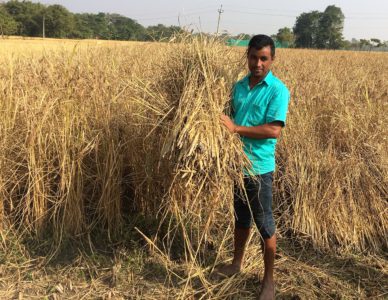
As farmers look to grow more food for their families and the marketplace, increasing production sustainably remains a consistent challenge. But a CIP project in Assam, India, has discovered an easy way to produce an annual crop of potatoes with no tillage and few additional inputs.
In Assam, farmers grow two rice crops a year with a short winter period in between. A World Bank project in the area consulted CIP to see if potatoes could be added to the annual cycle. Brijesh Kumar, an associate scientist for CIP, investigated the possibility.
Each rice harvest leaves large quantities of straw that is tall and thick. Ordinarily, crop litter like this might be used for feed, but rice straw is high in silica and lignin, which livestock cannot digest easily.

Kumar and his team found that rice straw could be used instead to cover potatoes on the soil surface and insulate them well enough to produce a good harvest in a little less than three months. Farmers have more food with very little work and inputs.
Better yet, the potatoes require no irrigation as the roots can draw water from the residual moisture left after the rice harvest.
Farmers have quickly adopted this method because it does not require difficult labor and can be performed by any member of the household. Big, clean tubers can be harvested simply by removing the straw (photo). Farmers have also noted a reduction in pests such as potato tuber moths. To date, 45 farmers have adopted this practice on 28 hectares of land.

Because the straw eventually goes back into the soil, the process reduces the overall carbon footprint of rice production and the potatoes do not contend with soil disease because they are grown on the surface.
While the early results are promising, more research is needed. CIP virologist, Jan Kreuze, says farmers and researchers want to know more about using straw mulch to reduce virus infections delivered by insects and how this practice could affect overall soil and environmental health long-term.
